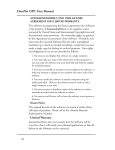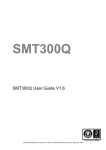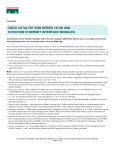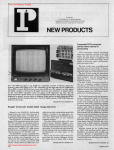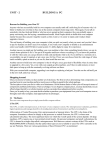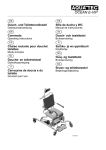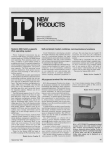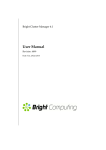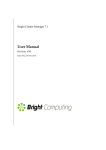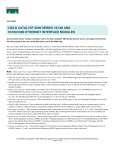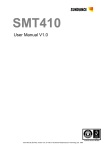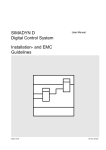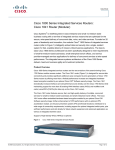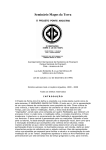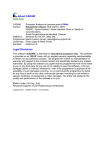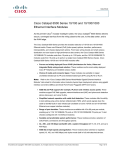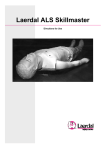Download New Products
Transcript
NEBA PR New Products Editor: Prof. Demetrios A. Michalopoulos California State University, Fullerton Four DPS-8 models added to CP-6 large-scale computers Honeywell has added four DPS-8 largescale host computers to its Control Program 6 multiuser systems as part of a program to expand the growth path for current users of the CP-V and CP-6 operating systems. Accommodating up to 120 simultaneous users, the models added are the DPS 8/62C, the DPS 8/44C in single- and dual-processor configurations, and DPS 8/20C. The DPS 8/62C is a 120-user, single-processor system field-upgradable to a DPS 8/70C, the company's most powerful computer. The freestanding central system comprises one CPU, one system control unit, and one l/O multiplexer with 35 channel function slots expandable to 54 slots. A typical configuration includes a Datanet 8C front-end network processor with 120 communications lines, a 1200-lpm and a 1600-lpm printer, a 1050-cpm card reader, four 200-ips tape drives, and four disk drives. The DPS 8/44C central system consists of one or two CPUs, a system control unit, and one l/O multiplexer with 19 channel function slots. The single-processor, 40-user DPS 8/44C in a typical configuration includes a Datanet 8C front-end network processor with 40 lines, a 1200-lpm printer, a 500-cpm card reader, two 200-ips tape drives, and a disk drive. The dual-processor, 80-user configuration of the DPS 8/44C typically comprises a Datanet 8C front-end network processor with 80 lines, a 1600-lpm printer, a 500-cpm card reader, three 200-ips tape drives, and two disk units. The DPS 8/20C is a 20-user system fieldupgradable to a DPS 8/44C. Designed for use either as an entry-level, freestanding CP-6 system or as a remote CP-6 satellite in conjunction with larger host systems, the DPS 8/20C in typical configuration includes a Datanet 8C front-end network processor with 20 lines, a 1200-lpm printer, a 500-cpm card reader, a 200-ips tape drive, and two disk units. The central systems for all of the host computers include user storage, an integrated communications processor based on Datanet 8 hardware, remote diagnostic processor, cache memory, and operator console. In typical configurations, the host computers are priced at $1,681,287 for the DPS 8/62C; $615,744 for the single-processor DPS 8/44C; $1,003,038 for the dual-processor DPS 8/44C; and $496,723 for the DPS 8/20C. Reader Service Number 41 June 1981 Reader Service Number 43 System provides MICR and OCR document encoding With 192K-byte error-correcting MOS memory expandable to 1920K bytes, a system console CRT, an 80M-byte disk, and a ninetrack, 1600-bpi tape drive with controller, the Harris 300 is priced at $104,950. Delivery is 90 days after receipt of order. Burroughs Corporation's S590 document encoding system encodes documents in either magnetic ink character recognition or optical character recognition type fonts. The S590, with a control system based on advanced microprocessor technology, utilizes PROM, providing the machine with a fully programmed MICR/OCR code line with one to eight fields. Based on the PROM program, fields are encoded in a controlled index sequence. Documents are transported through the encoder at 75 ips. The S590 audit tape lister prints at 2.5 Ips. The system has a rated speed of up to 70 documents per minute for encoding a 12-character amount field. The basic S590 with MICR capability sells for $7790 and leases for $261 a month on a three-year contract. Reader Service Number 42 Reader Service Number 44 48-bit supermini features error-correcting main memory A 48-bit superminicomputer system, the Harris 300 is fully compatible with other systems in the present Harris line and utilizes the company's Vulcan operating system. Utilizing a powerful 48-bit word architecture and compact magnetic peripherals, the system provides up to two million bytes of real memory and over 12 million bytes of virtual memory. Features include error-correcting main memory, integral 80M-byte Winchester-type disk, streaming tape drive, and use of up to 48 interactive terminals. A scientific arithmetic unit which supports floating-point operations independent of the central processor is optional. 3M's automated Scotchflex DIP plug connector and assembly machine permits termination of 14. or 16-pin DIP connectors to flat cable, with jumpers or daisy-chain configurations, at rates exceeding 600 terminations per hour. The unit operates with standard 120V power supply. The terminator costs $945.50. Languages offered with the system include Fortran 77, Extended Basic, Cobol, APL, RPG II, Harris Macro Assembler, and Pascal. Communications support packages which allow the H300 to emulate most commonly available protocols as both a host and a terminal are also available. 93 Subroutine detects, corrects keystroke errors on the fly Selfix Corporation's SelfixO6 Cobolcallable subroutine automatically detects and corrects keystroke errors on the fly in data en- try applications. Currently implemented on IBM mainframes, the package is intended for The Mega-4 is available in 32K-, 64K-, 128K-, 256K-, and 512K-byte configurations priced respectively at $680, $1000, $1520, $3675, and $5775. OEM discounts are available, and delivery is in two to four weeks. They can be populated with either 16K or 64K RAMs. All memory devices are socketed and each card undergoes a 168-hour burn-in at elevated temperatures. Warranty is 180 days. on-line or batch validation of numeric data entered from turnaround documents. The subroutine automatically corrects all single-digit errors and all transpositions of adjacent digits. It also detects-but does not correct-more than 99.9 percent of all errors other than single-digit errors and transpositions, according to the company. The subroutine is first invoked by the user program that is to print a turnaround document-such as a mailing label, an invoice, or an inventory list. The user program supplies an 11-digit data field to be protected and commands SelfixO6 to generate a corresponding six-digit check field that the user program will print on the document along with the data field. Later, the subroutine is invoked in the data entry process by the program that is validating the entered data. The user program commands SelfixO6 to analyze the entered 17-digit data-field/check-field combination. If it discovers a correctable error, it makes the correction, restoring the field to its proper value, and issues a return code to inform the user program of the action taken. It also passes the location of the error to the user program. If an uncorrectable error is detected, the subroutine sets the return code accordingly, but does not attempt any further action. To incorporate SelfixO6 into an existing data entry system, the user must alter existing report programs and data validation programs to call the subroutine and to take appropriate action after it operates. The ANS Cobol call statement is used to invoke the subroutine. Running in 6K bytes of memory on an IBM 360, 370, 3OXX, or 43XX computer under any standard operating system, the software chooses check fields to create 169 aliases for each user-furnished data field. The proprietary algorithm is designed so that a given 17-digit number can be an alias of only one check-field/data-field combination. The program, in checking entered data, determines whether the number is an original (i.e., errorfree) combination, an alias, or neither. If it is an original, the return code is set to indicate that no errors were detected. If it is an alias, the original is recovered. If it is neither, the existence of an uncorrectable error is conveyed to the user program. Users can write their own programs to analyze SelfixO6 outputs and correlate the statistics with other information to produce management reports that help to evaluate the effectiveness of data entry operation. The package includes a self-installing executable module, ready for insertion into the relocatable library (DOS) or system library (OS); a user's manual; a sample Cobol source program that calls SelfixO6; a one-year warranty on repair of program bugs; and a 30-day unconditional money-back guarantee. Reader Service Number 46 Reader Service Number 47 Vector General's VG 8250 third-generation graphics display system emulates IBM 3250 graphics display equipment and supports CADAM, a CAD/CAM programming system developed by Lockheed Aircraft Company. Twelve remote display station sites can be located up to three miles from the host computer. The VG 8250 channel speed of 1.2M bps and operation of the selector, block multiplexer, or byte multiplexer in real mode produces a system that can effectively support 32 terminals. The communication line of three megabits per second allows eight terminals at a site to be supported without degradation in display station response at large clustered sites. Other enhancements include, a hand-held tablet/digitizer, a maintenance/data management supervisor, continuous rotation and scaling of characters, and an electrostatic plotter option. Reader Service Number 45 512K-byte memory card is Multibus-compatible The Mega-4 memory card introduced by Matrox Electronic Systems Ltd. of Canada satisfies the large memory requirements of high-performance 8-bit (8085, Z80A) and 16-bit (8086) microcomputer systems. It contains up to 512K bytes of fast read/write memory, a memory management unit, distributed refresh, and full parity generating/checking circuitry. Byte-wide 8-bit and word-wide 16-bit data transfers are supported, and an advance acknowledge signal is provided as a jumper option. Worst-case access time is 625 ns with a cycle time of 725 ns. The memory management unit, or MMU, consists of two identical banks of 128 address translation registers that are loaded by the system CPUs to specify the mapping of the 64 physical memory segments (8K bytes per segment) on board the Mega-4 into the 128 logical memory segments in the IM-byte Multibus address space. Six bits in each MMU register specify the mapping of a given segment and two bits specify the memory segment atrribute-i.e., read only, write only, read/write, or read/write disable. The MMU gives 8086-based systems the same segmented addressing as found in Z8000 systems. The MMU feature facilitates multiprogramming since a supervisor program has simply to load the MMU registers with the appropriate memory map as each user is run. It also permits instantaneous relocation of programs and unlimited expansion of system memory. When the MMU is disabled by jumper option, the Mega-4 reverts to a standard memory card whose base address is strap-selectable for any 32K-byte boundary. Parity generating/checking is performed on each byte, and an interrupt is generated on parity error. COMPUTER Disk operating system added for Ti's TM990 family Eyring Research Institute's PDOS/Expres multiuser, multitask development operating system is designed for Texas Instruments' 16-bit TM990 microprocessor module family. The system includes an 8K-byte PDOS module, an advanced Expres Basic language interpreter, a character and a screen editor, an assembler, a floating-point package, and user utility enrichments for program development. PDOS supports large or small floppy disks, bubble memories, hard disks, and extended memory capabilities of up to 256K bytes. It supports up to 16 concurrent user tasks with prioritized round-robin clock-swapping. Up to 32 contiguous or noncontiguous files can be simultaneously open in sequential, random, shared, and read-only access modes. The Expres Basic intepreter uses advanced interpreting techniques to approach execution speeds of common threaded code compilers while maintaining an interactive approach to program development. Other features include multiline and recursive functions with local variables, variable names of unlimited length, Reverse Polish pseudosource token storage, context-oriented string-handling, a full set of disk interface primitives, hex number conversions, assembly language linkage, and color graphic command primitives. PDOS/Expres is shipped on large or small floppy disks and retails for approximately $1500. Reader Service Number 48 Phoenix Datat has introduced a high-speed buffer memory for radar digitizing applications. The MEM-1112 is housed in a rackmount chassis with power supplies and blowers. Features include four UHF andI four VHF channels that accept 12-bit data at 20 MHz, double buffered memory, and a common coritrol logic module that performs timing, channel selections, read/write control, output data storage, test functions, status, and interface to a Westinghouse signal processor. Output data rate is 10 MlHz. Power required is 120 VAC at 60 Hz. Reader Service Number 50 Two batch processors transfer data at 1 6M bps Four-Phase Systems has added two batch processors which are IBM software- and media-compatible. The Systems 311 and 312 processors allow users of Four-Phase distributed processing systems to off-load their IBM mainframe host computers by transferring batch applications to remote sites. Systems 311 and 312 are 32-bit processors compatible with the instruction set and l/O channel interface of the IBM 370. Coupled with the company's interactive front-end Systems IV/60, IV/65, IV/80, IV/90, or IV/95, a System 311 or 312 creates a more powerful system capable of providing data entry, data-base inquiry, word processing, and local data processing. According to Four-Phase Systems, System 311 is comparable in power to the IBM 4331 Group 1. System 312, which includes a 32K-byte cache memory, offers twice the performance of the 311 and is comparable to the IBM 4331 Group 2. Disk capacities range from IOOM bytes to 1600M bytes. Tape drives of 37.5 or 75 ips are supported. The company's interactive front-end systems and the Systems 311 or 312 can be tightly coupled via a high-speed bidirectional channel interface over which batch jobs are transferred. A low-speed communications channel connection is available for loosely coupled applications. Both systems utilize a classic bus architec- June 1981 ture, capable of 16M-bps transfer rates. The microprogram-controlled CPU can execute nonmemory-dependent microsteps concurrent with l/O transfers. It uses a control store to implement the 177 instructions of the IBM 370 instruction set. A dynamic address translator facility translates 24-bit logical addresses into real memory addresses. Thus, the CPU can address a logical space of 16M bytes, supporting virtual memory operations. Minimum memory configurations are 512K bytes for the System 311 and I M byte for the System 312. Both can be expanded in I M-byte increments up to 4M bytes. The memory uses 16K-bit dynamic MOS chips with a nominal 200-ns access time. System 311 is available as a back-end distributed batch processor. System 312 will be available in the fourth quarter. A sample configuration of the System 311, based on a 42-month lease, costs under $3000 per month. This includes a 311 processor with IM byte of memory, a console, lOOM bytes of disk, a tape drive, 16 communication lines, and a 300-lpm printer. The cost of a sample System 312, based on a 42-month lease, is under $4000 per month. This includes a 312 processor with IM byte of memory, a console, 200M bytes of disk, a tape drive, eight communication lines, and a 300-lpm printer. Reader Service Number 49 FREE 48-Page Catalog A new, free 48-page catalog is free from Creative Computing and Peripherals Plus. To help buyers make intelligent purchasing decisions, the product descriptions are exceptionally comprehensive and include screen photos in the software section. The catalog describes 20 books on programming, games, and educational applications; 160 software packages for Apple, Atari, TRS-80, PET, CP/M, TI, Sorcerer and Sol computers; 3 magazines (Creative Computing, Microsystems, and SYNC); 5 graphics and music peripherals; an LP record; board game; 8 T-shirts and an eclectic assortment of other products for the personal computer user. To get your free copy, simply drop a card or note to the address below. |ceative compazting Attn: Abby 39 East Hanover Avenue Morris Plains, NJ 07960 High-speed coaxial data modem operates on any frequency pair A high-speed coaxial data modem designated the Coax Modem and jointly produced by Catel and Prentice Corporation A general-purpose minicomputer, the PDP-11/24 offers four times the memory expansion of the PDP-11/34A and twice the memory and performance of the PDP-11/04, according to Digital Equipment Corporation. Optional features include a floating-point instruction set, 22-bit extended addressing capabilities for memory expansion to a megabyte, and battery backup. combines separate RF and data component packages in one module. Offering switch-selectable rates from 2.4K to 28.8K bps, the modem can be spaced 200 KHz apart in the 4 to 200 MHz range. Up to 30 high-speed data channels can be placed in one 4 to 200 MHz range. Up to 30 high-speed data channels can be placed in one standard 6 MHz TV channel assignment. The modem is broadband coax/CATVcompatible and designed for a standard RS232C/CCITT V.24 data interface. It operates on any frequency pair available on an existing CATV/CCTV system, allowing data transmission to be integrated into systems already servicing television, audio, and other signals. The unit features digitally generated waveforms and operates in internal, external clock, or repeater timing modes. Its front panel has both RF and data diagnostics. Frequency translators are available if turnaround of the data signal is required. In addition, RF modulator and demodulator sections are of modular construction and can be changed for field service or frequency changes. In single quantities, the Coax Modem is priced at $1895. Reader Service Number 53 Digital introduces entry-level PDP-1 1 Priced from $11,000 as a stand-alone unit, Digital Equipment Corporation's PDP- 11/24 minicomputer features megabyte memory capacity, midrange PDP-1 1 capabilities, custom MOS/LSI technology, and Unibus architecture. The unit employs a single hex-height central processor module with custom MOS/LSI technology, as well as the extended instruction set and memory addressing previously available only on the PDP-11/44 and the PDP-1 1/70. The central processor is available in 5¼/4" and 10"2' high chassis. The smaller one provides a maximum 768K-byte memory by using a 22-bit extended addressing option. The larger chassis accepts a full megabyte of memory. The PDP-11/24 is also available in three standard packaged systems running under the RT- II, RSX- 11, and RSTS/E operating systems. The first has 128K-bytes of memory, dual RX02 floppy disk drives, and a choice of a DECwriter IV hard-copy or VTIO0 video terminal. The second has 256K-bytes of memory, dual RL02 10.4M-byte disks, and a choice of a VT100 or DECwriter III terminal. The third has 256K-bytes of memory, dual 28M-byte RK07 disk drives, and a DECwriter 1II terminal. output. The package features Calcomp-compatible subroutine names and argument sequences, full source code, and a user's manual. It is written in ANSI standard Fortran IV, and versions are available for RDOS Fortran 4 or 5 and AOS Fortran 4 or 5. The main Calcomp-standard routines are plot, line, axis, symbol, number, scale, factor, 96 Votan Corporation's development system, the V1000, is designed for system development and evaluation by organizations interested in using Votan's proprietary voice technology. According to the company, the VIOOO is trained to a user's voice print by pressing a word button and speaking into a microphone. The unit recognizes isolated words or commands in any language, and can be used to enter data, activate machines, or control remote processes. and where. In addition, two high-level routines, PPLXY and PPLDB, produce complete plots with one call. The lowest level routine, point, allows a single dot to be placed anywhere on the page; any shape can be generated by calling this routine in a loop. Priced at $950, the package is delivered on a nine-track, 800-bpi magnetic tape. Other media are available at additional cost. Maintenance for 90 days is included in the purchase price. A stand-alone development system, the VIOOO contains all the processing power, logic, and memory necessary to perform training and word recognition, as well as to interface with external equipment. The portable unit consists of an 11" x 18" front panel with 80 word buttons and 14 control keys. Up to 80 double-trained words can be entered using the training panel, and up to 160 single-trained words can be entered with an external display and control processor. An optional switching unit is available for direct voice activation of machinery and other industrial loads. In addition to its use as a development tool, the V1000 can be used in its present form for voice data entry into an on-line system. The V1000 is priced at $10,000, with delivery 30 days after receipt of order. Reader Service Number 52 Reader Service Number 54 Reader Service Number 51 Graphic output produced with Fortran-callable subroutines Rhintek's software plotting package for the Data General LP2 printer contains Fortrancallable subroutines for production of graphic Development system can be trained to user's voice print COMPUTER




